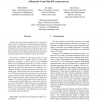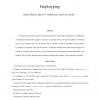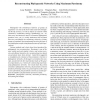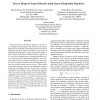105
Voted
CSB
2005
IEEE
15 years 6 months ago
2005
IEEE
Experimental processes to collect and process proteomics data are increasingly complex, while the computational methods to assess the quality and significance of these data remain...
106
Voted
CSB
2005
IEEE
15 years 6 months ago
2005
IEEE
Perhaps the most common question that a microarray study can ask is, “Between two given biological conditions, which genes exhibit changed expression levels?” Existing methods...
76
Voted
CSB
2005
IEEE
15 years 6 months ago
2005
IEEE
We study the parsimony approach to haplotype inference, which calls for finding a set of haplotypes of minimum cardinality that explains an input set of genotypes. We prove that ...
106
Voted
CSB
2005
IEEE
15 years 6 months ago
2005
IEEE
We present a software package which can detect homozygous SNPs and indels on a eukaryotic genome scale from millions of shotgun reads. Matching seeds of a few kmer words are found...
100
Voted
CSB
2005
IEEE
15 years 6 months ago
2005
IEEE
A linear programming algorithm is presented to constructively compute thermodynamically feasible fluxes and change in chemical potentials of reactions for a metabolic network. It...
99
Voted
CSB
2005
IEEE
15 years 6 months ago
2005
IEEE
Phylogenies—the evolutionary histories of groups of organisms—are one of the most widely used tools throughout the life sciences, as well as objects of research within systema...
CSB
2005
IEEE
15 years 6 months ago
2005
IEEE
Metals bound to the protein are important for functional or structural roles. Despite their importance there is a distinct lack of research for identification of metalloproteins f...
74
Voted
CSB
2005
IEEE
15 years 6 months ago
2005
IEEE
Recently Bowers et al. [1] analyzed triplet logic relationships among 4873 Clusters of Orthologous Groups (COGS) from 67 fully sequenced organisms by calculating how well logic re...
88
Voted
CSB
2005
IEEE
15 years 6 months ago
2005
IEEE
We have previously developed a method [1] for the inverse design of small ligands. This method can be used to design novel compounds with optimized properties (such as drugs) and ...
95
Voted
CSB
2005
IEEE
15 years 6 months ago
2005
IEEE
This work presents the development of algorithms for approximate string matching using parallel methods. It intends to do the maximum of molecular sequences comparisons per unity ...




